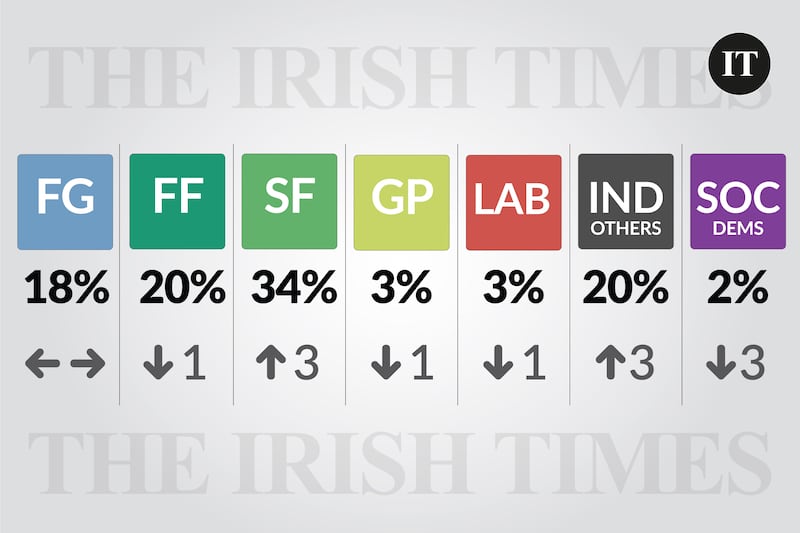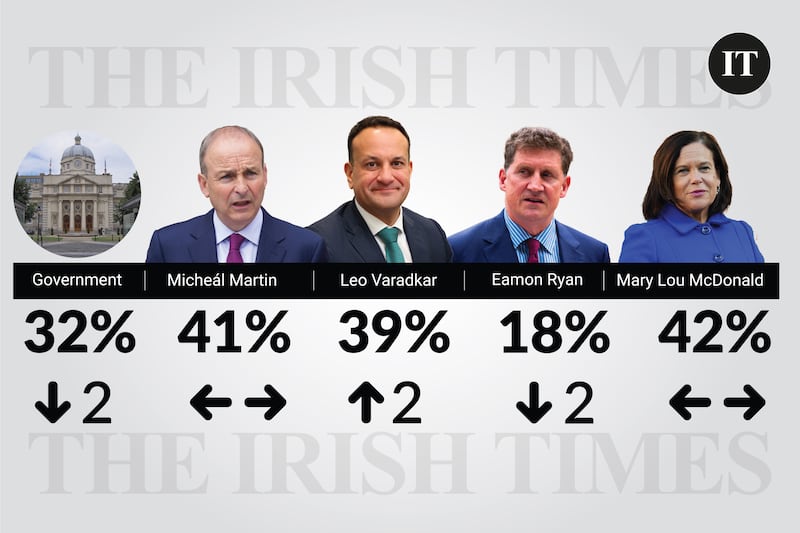The latest Irish Times/Ipsos poll paints a familiar picture of party support, with Sinn Féin in the ascendancy and the three Government parties struggling to make headway.
Sinn Féin has regained most of the ground lost in the last Irish Times/Ipsos poll, rising three points to 34 per cent. Over the past two years the party has consistently attracted the support of about one in every three voters.
Fine Gael (unchanged on 18 per cent), Fianna Fáil (down one to 20 per cent) and the Green Party (down one to 3 per cent) are all at or close to recent lows. When combined, support for the three parties of Government is just 41 per cent.
Labour are on 3 per cent, down one point.
READ MORE
Within the Independents/Others Party grouping (unchanged on 22 per cent), independent candidates have enjoyed a collective boost, up four points to 18 per cent, whereas the Social Democrats have given up their recent gains, falling three points to 2 per cent. With 1 per cent support apiece are People Before Profit-Solidarity (down one point) and Aontú (unchanged).
Fieldwork for today’s poll took place between Sunday and Tuesday of this week, among a representative sample of 1,200 eligible voters. In-person interviews were conducted in every county and in every constituency to provide a fully national picture of public opinion.
The background to today’s poll is a potential giveaway budget in two weeks’ time. Caught between a rock and a hard place, the Coalition needs to strike balance between using some of the budget surplus to help citizens battle a cost-of-living crisis but not, as the Irish Fiscal Advisory Council warns, “amplifying demand in an economy already operating at capacity”.
Much pressure has been put on the Government to be frugal but maintaining a budget surplus, keeping a lid on spending and saving for the future is not a vote-winning strategy. In fact the strength of our public finances denies the Government the opportunity to blame a shortage of money for a lack of services and spending power.
Ipsos sentiment tracking research shows housing to be, by far, the number one item on the agenda for voters. It therefore comes as no surprise that Sinn Féin is attracting votes among the under 35, where they register 43 per cent support, compared with just 29 per cent for the three Coalition parties combined.
[ Sinn Féin extends lead to stay on course to be largest party in next Dáil, latest opinion poll shows ]
[ Poll analysis: Parties big and small being squeezed by Sinn Féin juggernaut ]

Young people are most concerned about housing, but it would be fair to say that all of Irish society has a stake in solving the problem of affordability and availability. The ubiquity of the issue has no doubt given Sinn Féin access into every nook and cranny of the electorate. Remarkably, Sinn Féin is the most popular party among every demographic, except the over 65s, where Fianna Fáil leads on 35 per cent, and among farming households, where Fine Gael leads on 31 per cent.
For Fine Gael, Fianna Fáil, the Greens and Labour, their poll performances over the past two years are best described as range bound. Fine Gael has consistently polled within the 18-22 per cent range, while Fianna Fáil has remained within the 18-23 per cent range. Both the Green Party and Labour have polled at either 3 or 4 per cent in each of the last six Irish Times/Ipsos polls. If we allow for natural statistical variation, it is not possible to conclude with a high degree of confidence that anything has changed.
Leader satisfaction ratings have not moved significantly, if at all. Sinn Féin’s Mary Lou McDonald is on 42 per cent (unchanged), Fianna Fáil’s Micheál Martin is on 41 per cent (unchanged), Fine Gael’s Leo Varadkar is on 39 per cent (down two points) and Green leader Eamon Ryan is on 18 per cent (down two points).

A mutual respect among Fine Gael and Fianna Fáil voters for how well their party leaders have worked together in Government is noticeable from the data. Cross-party leader approval ratings are favourable – Fianna Fáil voters give Varadkar a 60 per cent rating, while Fine Gael voters give 70 per cent.
Fianna Fáil and Fine Gael supporters are less convinced about Ryan, together scoring the Green Party leader (24 per cent) lower than they score McDonald (31 per cent).
Overall, satisfaction with the Government is at 32 per cent (down two points) and one of the lowest ratings for this Coalition. Perhaps Budget 2024 will provide new impetus, but all the signs are that it will take a lot more than giveaways for the Government to reach escape velocity and regain the approval levels enjoyed earlier in its term.










